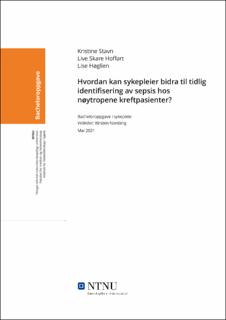| dc.contributor.advisor | Nordang, Kirsten | |
| dc.contributor.author | Stavn, Kristine | |
| dc.contributor.author | Hoffart, Live Skare | |
| dc.contributor.author | Høglien, Lise | |
| dc.date.accessioned | 2021-09-24T19:51:50Z | |
| dc.date.available | 2021-09-24T19:51:50Z | |
| dc.date.issued | 2021 | |
| dc.identifier | no.ntnu:inspera:77258684:81467780 | |
| dc.identifier.uri | https://hdl.handle.net/11250/2782369 | |
| dc.description.abstract | Bakgrunn: Kreftpasienter med nøytropeni er spesielt utsatt for infeksjon og sepsis. Denne pasientgruppen har hele ti ganger høyere risiko for å utvikle sepsis enn normalbefolkningen. Sykepleier har et overordnet ansvar for observasjon og vurdering av pasienter. Ved forsinket identifikasjon og behandling, vil tilstanden raskt forverres og prognosen bli dårligere.
Hensikt: Vurdere hvordan sykepleier kan bidra til tidlig identifikasjon av sepsis hos pasienter med cytostatikaindusert nøytropeni, samt å belyse viktigheten av dette.
Metode: Litteraturstudie. Studien inkluderer sju forskningsartikler, derav seks av disse er kvantitative og en kvalitativ. Samt annen relevant litteratur som er med å belyse problemstillingen.
Resultat: Funn fra de valgte artiklene viser at skåringsverktøy som SOFA-, qSOFA- og NEWS-skår er gunstige ved identifisering av sepsis. Disse er derimot ikke rettet spesielt mot pasienter med nøytropeni. Normale infeksjonstegn blir ofte kamuflert grunnet tilstanden nøytropeni, og kan være vanskeligere å fange opp. Feber er ofte eneste symptom på infeksjon, likevel viser funn at ikke alle får feber. Å implementere andre spesifikke skåringsverktøy kan dermed være gunstig. MASCC trekkes frem som et hensiktsmessig verktøy for vurdering av grad av nøytropeni og risiko for utvikling av blant annet sepsis. Funn viser også manglende kompetanse hos sykepleier, samt misvisende og fraværende informasjon og veiledning til pasient og pårørende.
Konklusjon: Tidlig identifikasjon vil redusere dødeligheten hos pasienter med nøytropen sepsis. Sykepleiers kunnskap og kompetanse sammen med spesifikke og generelle skåringsverktøy vil være hensiktsmessig. qSOFA-, NEWS- og MASCC-skår kombinert fremstår som gode verktøy for vurdering av nøytropene pasienter. Feber kommer frem som en viktig observasjon hos pasienter med nøytropeni, da dette ofte er eneste fremtredende symptom på infeksjon. Som sykepleier har en et overordnet ansvar for observasjon og vurdering av pasienter. Kunnskap innenfor nøytropeni og risiko for sepsis, samt informasjon, veiledning og samhandling vil være avgjørende for tidlig identifikasjon.
Nøkkelord: Cancer, neutropenia, sepsis, screening tool, nursing. | |
| dc.description.abstract | Background: Cancer patients with neutropenia are particularly susceptible to infection and sepsis. This patient group has a 10 times higher risk of developing sepsis than the normal population. A nurse has the overall responsibility for observation and assessment of patients. In case of delayed identification and treatment, the condition will quickly worsen, and the prognosis will deteriorate.
Objective: To assess how a nurse can contribute to early identification of sepsis in patients with cytostatics-induced neutropenia, as well as to shed light on the importance of this.
Method: Literature study. The study is based on seven research papers, six of which are quantitative, and one is qualitative. This in addition to other literature relevant to the problem.
Results: Findings from the selected articles show that scoring tools such as SOFA, qSOFA and NEWS-scores are beneficial when identifying sepsis. However, these aids are not specifically targeted at patients with neutropenia. Normal signs of infection are often camouflaged due to the condition neutropenia, and sepsis might therefore be more difficult to diagnose than normal. Fever is often the only symptom of infection, yet findings show that not everyone infected also has fever. Implementing other specific scoring tools can thus be beneficial. MASCC is highlighted as an appropriate tool for assessing the degree of neutropenia and the risk of developing sepsis. Findings also show lack of competence among nurses and misleading or absent information and guidance to patients and next of kind.
Conclusion: Early identification will reduce mortality among patients with neutropenia sepsis. Nurses' knowledge and competence together with specific and general screening tools will be of high importance. qSOFA, NEWS and MASCC scores combined appear as good tools for assessing neutropenic patients. It is also highlighted that fever is an important observation in patients with neutropenia, as this is often the only prominent symptom of infection. The nurse is the person with the overall responsibility for observation and assessment of patients. Knowledge within neutropenia and risk of sepsis, as well as information, guidance and interaction will be crucial for early identification.
Nøkkelord: Cancer, neutropenia, sepsis, screening tool, nursing. | |
| dc.language | nob | |
| dc.publisher | NTNU | |
| dc.title | Hvordan kan sykepleier bidra til tidlig identifisering av sepsis hos nøytropene kreftpasienter? | |
| dc.type | Bachelor thesis | |
